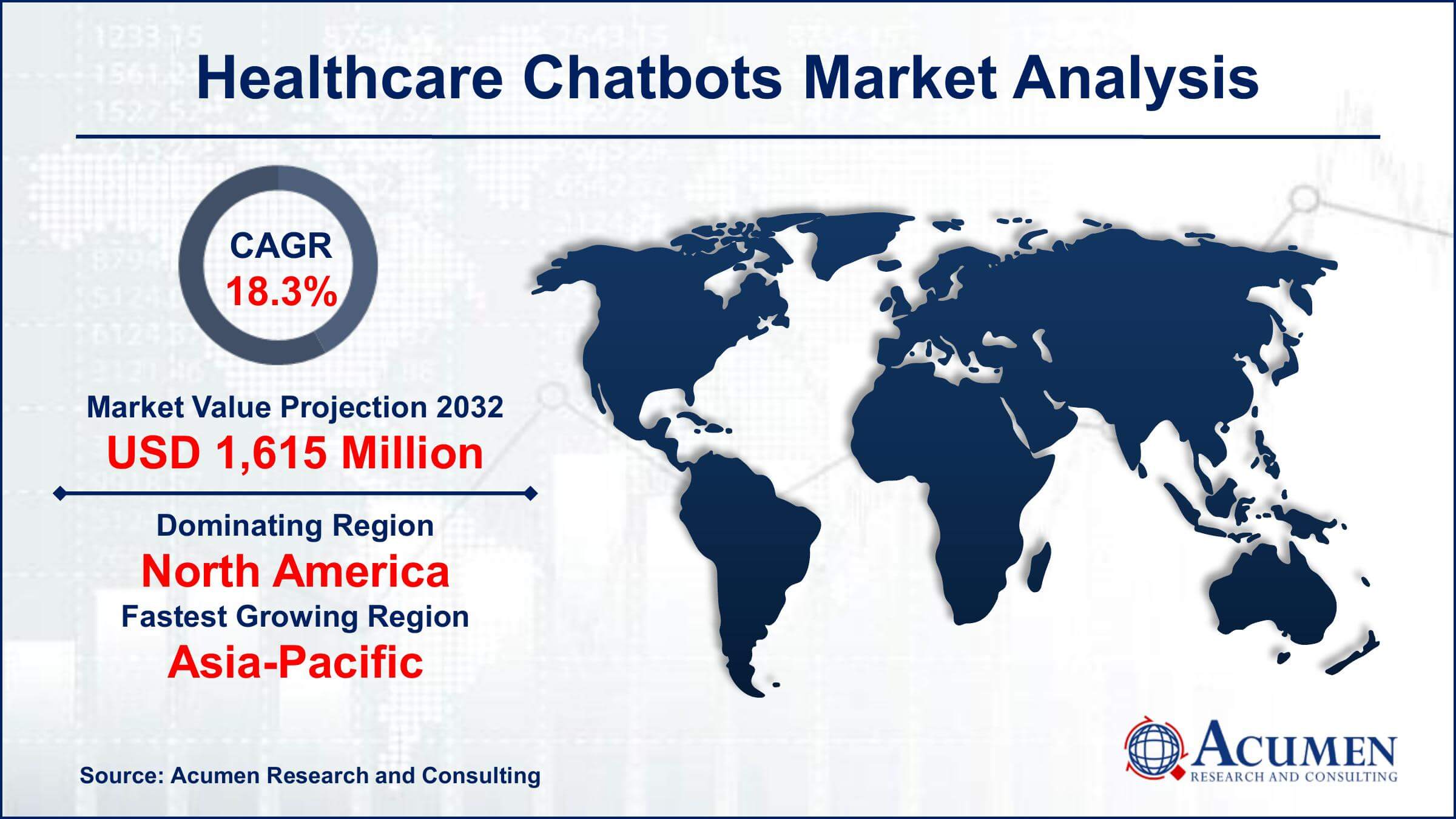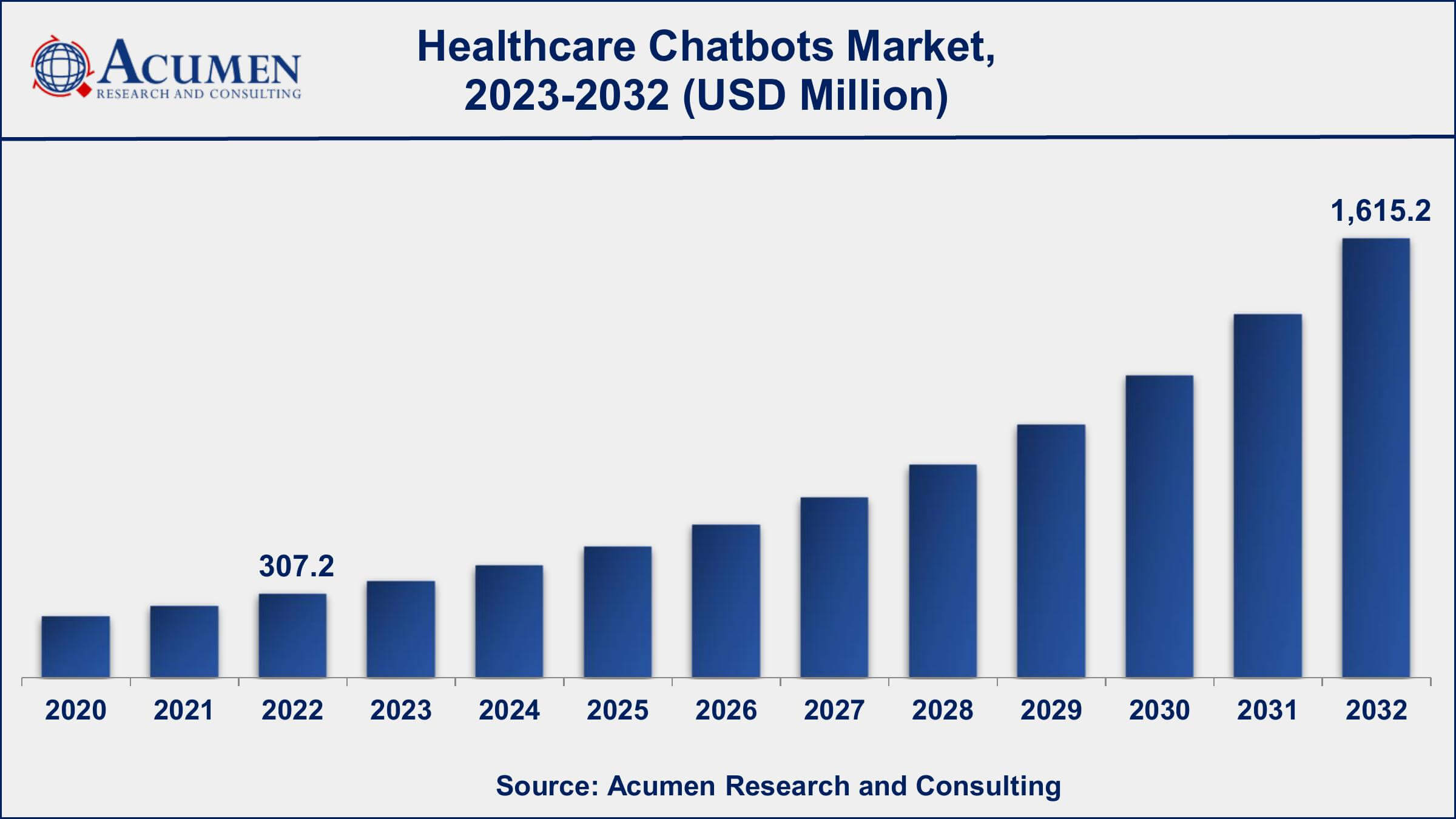December 2020
Healthcare Chatbots Market gathered USD 307.2 Million in 2022 and is expected to reach USD 1,615.2 Million by 2032, growing at a CAGR of 18.3% from 2023 to 2032.
The global Healthcare Chatbots Market gathered USD 307.2 Million in 2022 and is expected to reach USD 1,615.2 Million by 2032, growing at a CAGR of 18.3% from 2023 to 2032.
Healthcare Chatbots Market Highlights

Chatbots, also known as 'conversational agents,' are software applications used to engage in online chat conversations through text or text-to-speech. They are designed to mimic human speech, either in written or spoken form, to simulate interactions with real individuals. In the healthcare sector, chatbots are gaining popularity as they offer various services, such as appointment scheduling and reminders, along with providing health-related information to patients. This can help alleviate the workload of healthcare professionals, allowing them to focus on their core responsibilities.

Global Healthcare Chatbots Market Dynamics
Market Drivers
Market Restraints
Market Opportunities
Healthcare Chatbots Market Report Coverage
| Market | Healthcare Chatbots Market |
| Healthcare Chatbots Market Size 2022 | USD 307.2 Million |
| Healthcare Chatbots Market Forecast 2032 | USD 1,615.2 Million |
| Healthcare Chatbots Market CAGR During 2023 - 2032 | 18.3% |
| Healthcare Chatbots Market Analysis Period | 2020 - 2032 |
| Healthcare Chatbots Market Base Year |
2022 |
| Healthcare Chatbots Market Forecast Data | 2023 - 2032 |
| Segments Covered | By Component, By Deployment, By Application, By End-User, And By Geography |
| Regional Scope | North America, Europe, Asia Pacific, Latin America, and Middle East & Africa |
| Key Companies Profiled | Ada Digital Health Ltd, Ariana, Babylon Healthcare Service Limited, Buoy Health, Inc, GYANT.Com, Inc, Infermedica Sp. z o.o, Microsoft, PACT Care B.V, Sense.ly Inc, and Your.MD. |
| Report Coverage |
Market Trends, Drivers, Restraints, Competitive Analysis, Player Profiling, Covid-19 Analysis, Regulation Analysis |
Healthcare Chatbots Market Insights
The rising prevalence of chronic diseases, coupled with the shortage of patient’s experts to handle queries, is propelling market growth. The emergence of telehealth (the use of digital information and communication technologies) and remote healthcare in developing economies is supporting this growth. According to estimates from Anthem Insurance Companies Inc., nearly 52 percent of patients access their health data through applications, and around 36 percent of doctors approve the use of mobile applications for patient treatment. Additionally, chronic disease patients have started using technology for timely assistance. For example, cancer patients use chatbots to quickly access information related to medication and its adverse effects.
On the other hand, concerns related to data privacy, a lack of expertise in chatbot development, as well as a lack of awareness and misconceptions among untapped and emerging market audiences are some of the factors likely to hinder growth to some extent during the forecast period from 2023 to 2032.
Healthcare Chatbots Market Segmentation
The worldwide market for healthcare chatbots is split based on component, deployment, application, end-user, and geography.
Healthcare Chatbots Components
Based on the component, the software segment is currently leading the healthcare chatbots market with the highest revenue share and is projected to maintain its dominance over the forecast period. As per our healthcare chatbots industry analysis, increasing adoption of software in the healthcare sector to facilitate communication between healthcare providers and payers, as well as to reduce the time clinical professionals spend on conversations, are factors supporting the segment's market value.
Healthcare Chatbots Deployments
As per the healthcare cloud-based deployment model has dominated the healthcare chatbots market for several reasons. One of the primary factors driving this dominance is scalability. Cloud-based chatbots offer the flexibility to scale resources up or down based on demand, which is crucial in the dynamic healthcare sector where the volume of patient inquiries can vary significantly. This scalability ensures that healthcare organizations can efficiently handle a large number of concurrent interactions, making it ideal for applications like appointment scheduling, prescription refills, and general health inquiries.
Another key advantage of cloud-based chatbots is accessibility. Healthcare providers and patients can access these chatbots from anywhere with an internet connection, using various devices such as smartphones, tablets, or desktop computers. This accessibility aligns with the growing trend of telemedicine and remote healthcare, allowing patients to seek Patients information and assistance conveniently without the need for in-person visits.
Healthcare Chatbots Applications
As per the healthcare chatbots market analysis, symptom checking and patients assistance chatbots have gained significant popularity because they provide immediate and valuable support to patients. These chatbots can help users assess their symptoms, provide preliminary Patients advice, and offer guidance on whether they should seek further Patients attention. They are especially valuable for addressing immediate health concerns and offering initial recommendations, which can be critical in emergency situations or when individuals are unsure about their symptoms.
However, it's essential to note that the dominance of specific applications within the healthcare chatbot market can vary by region, healthcare system, and specific use case. Different chatbots may excel in different aspects of healthcare, and their dominance may depend on factors such as user preferences, the quality of the chatbot's algorithms, and the level of integration with healthcare providers and systems.
Healthcare Chatbots End-Use Industries
On the basis of end-users, the 'patients' segment is currently leading the healthcare chatbots market and is projected to maintain its dominance over the forecast period. Patients utilize these applications to gain a better understanding of their condition by accessing timely information. They can access chatbots through medical websites, mobile apps, and social media platforms to receive appropriate healthcare assistance based on their symptoms. Additionally, these chatbots can send notifications to patients to ensure they take their medication on time and can also alert them about missed dosages, allowing patients to plan their routines accordingly.
Healthcare Chatbots Market Regional Segmentation
North America
Europe
Asia-Pacific
Latin America
The Middle East & Africa
Healthcare Chatbots Market Regional Analysis
North America, particularly the United States, has been a leading adopter of healthcare chatbots. Factors driving growth include a well-established healthcare infrastructure, a high prevalence of chronic diseases, and a tech-savvy population. Stringent data privacy regulations, like HIPAA in the U.S., have influenced chatbot development to prioritize security and compliance.
Europe has seen growing adoption of healthcare chatbots, with countries like the UK, Germany, and France leading the way. The European market is driven by the need to reduce healthcare costs, improve patient access, and address the shortage of healthcare professionals. GDPR (General Data Protection Regulation) compliance is crucial in shaping chatbot deployment in Europe.
The Asia-Pacific region, including countries like India, China, and Japan, is experiencing rapid growth in healthcare chatbots. Rising healthcare expenditures, expanding telemedicine services, and increasing internet penetration contribute to market expansion. Local language support and culturally relevant chatbot interactions are essential for success in this diverse region.
Healthcare Chatbots Market Players
Some of the top Healthcare Chatbots companies offered in our report includes Ada Digital Health Ltd, Ariana, Babylon Healthcare Service Limited, Buoy Health, Inc, GYANT.Com, Inc, Infermedica Sp. z o.o, Microsoft, PACT Care B.V, Sense.ly Inc, and Your.MD.
Looking for discounts, bulk pricing, or custom solutions? Contact us today at sales@acumenresearchandconsulting.com
December 2020
April 2025
December 2021
August 2020